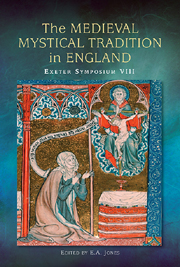 The Medieval Mystical Tradition in England
The Medieval Mystical Tradition in England Book contents
- Frontmatter
- Contents
- Lists of Diagrams and Figures
- List of Contributors
- Abbreviations
- Introduction
- The Colours of Contemplation: Less Light on Julian of Norwich
- Behold Not the Cloud of Experience
- Walter Hilton on the Gift of Interpretation of Scripture
- Numeracy and Number in The Book of Margery Kempe
- Religious Mystical Mothers: Margery Kempe and Caterina Benincasa
- Authority and Exemplarity in Henry Suso and Richard Rolle
- Mortifying the Mind: Asceticism, Mysticism and Oxford, Bodleian Library, MS Douce 114
- The Meditaciones of the Monk of Farne
- Envisioning Reform: A Revelation of Purgatory and Anchoritic Compassioun in the Later Middle Ages
- Walton's Heavenly Boece and the Devout Translation of Transcendence: O Qui Perpetua Pietised
- Reformist Devotional Reading: The Pore Caitif in British Library, MS Harley 2322
- Richard Whytford, The Golden Epistle, and the Mixed Life Audience
- Afterword: Future Prospects
- Index
Envisioning Reform: A Revelation of Purgatory and Anchoritic Compassioun in the Later Middle Ages
Published online by Cambridge University Press: 05 July 2013
- Frontmatter
- Contents
- Lists of Diagrams and Figures
- List of Contributors
- Abbreviations
- Introduction
- The Colours of Contemplation: Less Light on Julian of Norwich
- Behold Not the Cloud of Experience
- Walter Hilton on the Gift of Interpretation of Scripture
- Numeracy and Number in The Book of Margery Kempe
- Religious Mystical Mothers: Margery Kempe and Caterina Benincasa
- Authority and Exemplarity in Henry Suso and Richard Rolle
- Mortifying the Mind: Asceticism, Mysticism and Oxford, Bodleian Library, MS Douce 114
- The Meditaciones of the Monk of Farne
- Envisioning Reform: A Revelation of Purgatory and Anchoritic Compassioun in the Later Middle Ages
- Walton's Heavenly Boece and the Devout Translation of Transcendence: O Qui Perpetua Pietised
- Reformist Devotional Reading: The Pore Caitif in British Library, MS Harley 2322
- Richard Whytford, The Golden Epistle, and the Mixed Life Audience
- Afterword: Future Prospects
- Index
Summary
In the anonymous fourteenth-century poem,The Pricke of Conscience, its author focuses in considerable detail on the miseries of this life, the torments of Hell and Purgatory, and the joys awaiting the saved in Paradise. In Part Four of this text, we are presented with a detailed and theologically informed treatment of the doctrine of Purgatory as it was developing during the later Middle Ages, including details of the ‘payns seven’ (2897) which a soul could expect in Purgatory after death. According to this author, too, the boundaries between this world and the afterlife were permeable, with those left on earth being able to affect the course of a soul's expiation of sin before its triumphant entry into Heaven. Moreover, that soul could, under some circumstances, return to warn the living of what lay in store for them and thus bring about a mutual deliverance:
… thurgh helpe and spede
Of prayer of frendes and alumusdede,
Til wham þai ofte in gast apere,
Thurgh speciel grace, in sere stedes here,
For to hast þair deliverance. (2882-6)
Whilst Jacques Le Goff considered the purgatorial doctrine to have emerged at the end of the twelfth century, more recently, Takami Matsuda has argued that concerns about Purgatory only began to reveal themselves within an English literary context at the end of the thirteenth century, in which case the poem can be regarded as belonging to a new and innovative genre which sought to articulate a type of third space between Heaven and Hell in which a soul could atone for a range of earthly sins.
- Type
- Chapter
- Information
- The Medieval Mystical Tradition in EnglandPapers Read at Charney Manor, July 2011 [Exeter Symposium 8], pp. 141 - 156Publisher: Boydell & BrewerPrint publication year: 2013


